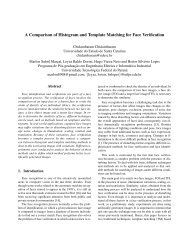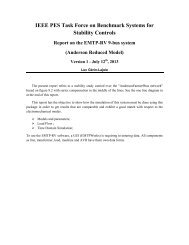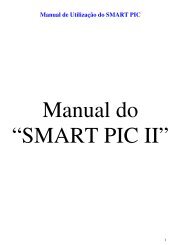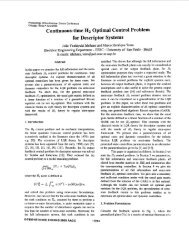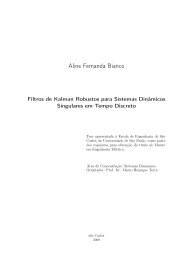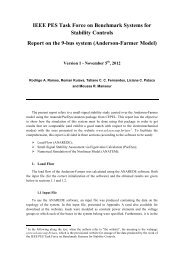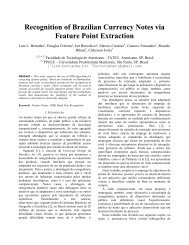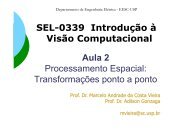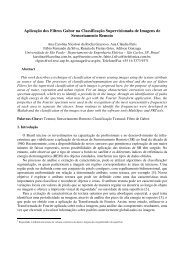III WVC 2007 - Iris.sel.eesc.sc.usp.br - USP
III WVC 2007 - Iris.sel.eesc.sc.usp.br - USP
III WVC 2007 - Iris.sel.eesc.sc.usp.br - USP
You also want an ePaper? Increase the reach of your titles
YUMPU automatically turns print PDFs into web optimized ePapers that Google loves.
<strong>WVC</strong>'<strong>2007</strong> - <strong>III</strong> Workshop de Visão Computacional, 22 a 24 de Outu<strong>br</strong>o de <strong>2007</strong>, São José do Rio Preto, SP.As the information in the highest resolution levels isoften largely affected by noise, they are di<strong>sc</strong>arded forthe following analysis. The authors concludedexperimentally that the fourth, fifth and sixth levels areenough to generate a good representation.The zero crossings of the dyadic wavelet transformof the row signals are determined for each of the 3 levelsmentioned above. These points occur on a<strong>br</strong>upt changein signal amplitude. Figure 5 shows a zero crossingrepresentation of the wavelet transform for a sample rowof the normalized image.Once the zero crossings have been located, theaverage value between each two consecutive zerocrossing points in the wavelet outcome is computed.So, working with normalized images with 16 rowsand 256 columns, as in the original Boles paper, the irisis represented by a matrix having 48×256 elements [5].MatchingTo compute the dissimilarity between two irises, theirzero crossing representations are compared. Bolesproposes four functions to measure the dissimilaritybetween the signals [5]. Hereafter only the dissimilaritymeasure defined in equation 1 is considered, since itprovided the best performance in the experiment<strong>sc</strong>onducted within this work. This is given bydjm( f , g)1N 1 n jZ f ( n) Z g(n m)0jEq. 1|| Z f |||| Z g ||jwhere d jm (f,g) denotes the dissimilarity of iris f and gassociated to the j-th row of their representationmatrices for a displacement m, the vectors Z j f and Z j gare the j-th row of the zero crossing representationsrespectively of irises f and g, N is the number ofelements of Z j f and Z j g, m,n [ 0 N-1] and the symbol“|| ||” represents the vector norm. Note that d jm (f,g) isequal to 1 minus the correlation coefficient betweenZ j f(n) and Z j g(n). Thus the dissimilarity d jm (f,g) may takevalues between 0 and 2, whereby 0 corresponds to aperfect match.Equation 1 is computed for each row of therepresentation matrices. For normalized images with 16rows and working with 3 resolution levels, this willreturn 48 values, whose mean is taken as thedissimilarity (D m ) between irises f and g, for a givenvalue of m.It is important to notice that m in equation 1represents shifts of the second signal. Varying m inequation 1 from 0 to N-1 yields N dissimilarity values(D m ). The overall dissimilarity D between irises f and gis given by.Dj minDmEq. 2m4. MethodologyThis section de<strong>sc</strong>ribes the extension toBoles method proposed in this work to deal withocclusion.It is assumed henceforth that the occlusion areas inthe normalized images (as in figure 2) were located in aprevious step. Methods have been proposed in theliterature to do it automatically [10].The basic idea consists in restricting the computationof dissimilarity to the values of the wavelet transformsnot influenced by occlusion. Since the wavelettransform is a neighborhood operation, it is affected byocclusion over a range the goes beyond the pixelsdirectly under occlusion. It includes the occluded pixelsthem<strong>sel</strong>ves and the pixels lying in a neighborhood ofsize w, where w is the width of the wavelet kernel.The approach can be better understood byconsidering Figure 4. It shows the same image of Figure2 where the occlusion regions are set to zero (black).Clearly, for a method that handles occlusion properly,Figure 2 and 4 must be equivalent.Let’s now take the j-th row of both images andcompute their wavelet transforms. They are illustrated inFigure 6 respectively by the dotted and by the dashedline. These two curves differ from each other only in theregion not affected by occlusion. A third curve, drawnby a continuous line in figure 6, is produced by zeroingany of the earlier curves only where they differ. Hence,to ignore pixels under occlusion, the similarity analysisshould be limited to the non zero values of this thirdcurve.Figure 6. Wavelet transformsThis idea is explained in more formal terms asfollows. Let’s Z j f and Z j g be the zero crossingrepresentation yielded by the wavelet transforms of thej-th row of a normalized image, like of the one shown inFigure 2. Similarly Z’ j f and Z’ j g are the zero crossingrepresentations of the same row but with zeros over286




